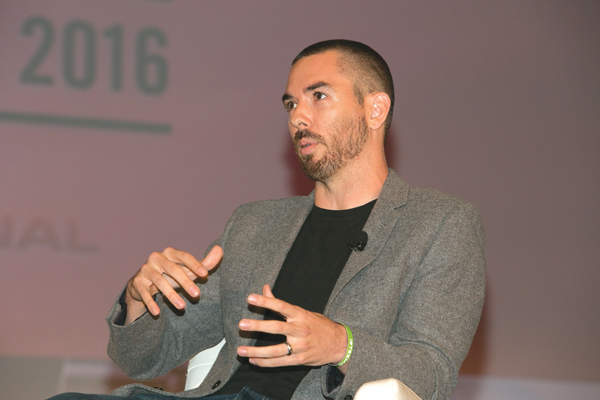
 |
Photo by: MARC BRYAN-BROWN
|
We actually took a lot of cues from professional sports as well as from professional sports broadcasting in terms of structuring leagues, helping to create teams and helping to create viable career paths for players that could actually convince their parents, when [they’re] like, “Hey, I’m not going to go to college, I’m going to go be a professional video game athlete.”
Oftentimes that’s a bit of a challenging conversation, although that’s becoming a little easier these days.
Agents and contracts and legal disputes and fines and … trade deadlines — all of this stuff is coming to esports.
With streaming, essentially what happens is players will broadcast themselves practicing, so it would be kind of like Kobe [Bryant] strapping a GoPro to his chest while he’s shooting around in the gym.
Then tens of thousands of people will tune in to watch him do that, and also be able to chat with him in real time.
It’s very much a pro/celebrity-driven sport, and a lot of these pro athletes and celebrities have now created massive fan followings around the world.
When some of my friends from Europe — as is typical, who aren’t American football fans — watch an NFL game, they just see a bunch of fat dudes running into each other, where I think a lot of people may look at “League of Legends” if they’re not familiar with the game and not understand a lot of the nuance.
Without being a rabid fan of the game itself or playing the game, just like somebody may watch a touchdown or a big hit and know what happens … you can tell when cool moves are pulled off by these pros.
There are really rabid fan bases for, say, NASCAR, which is a great sport but it tends to be sort of localized to the South. Esports faces a bit of a similar issue where it’s this huge generational divide, where if you’re under the age of 30, oftentimes you think it’s the coolest thing of all time.
Whereas if you’re 40-plus, you’re like, “What the hell is this?”
When we’ve worked with venue operators in the past they’ve sort of been like, “What? People, are they playing video games?” We’re like no, no, no. The audience isn’t playing video games. There’s only a couple of people playing video games. Everybody else is watching. It’s like, “Oh, OK.” The translation is sometimes difficult.
When we went to Wembley Arena in London, as an example, we brought in a massive amount of freight trucks for merchandise. One of the GMs there was like, “Whoa, what is all this stuff? You guys are crazy. You’re never going to sell through this stuff.”
And then we ended up doubling the previous record we had in terms of merch per attendee. I think it was previously [Justin] Bieber. So take that, Bieber.

One of the cool things is gamers essentially don’t stop playing games as they grow up, so the average age of a gamer is continuing to increase over time. Sometimes what happens is their ability or time to actively physically play the games themselves can trend down with families and careers and things like that, but … they still love to watch.
If “League of Legends” is football, a game like “Counter-Strike,” which is a first-person shooter, would be soccer. “Hearthstone,” which is a card game, would be hockey. So there are other sports, and typically, just like in traditional sports, there tends to be one league that sort of captures all the value, and then everyone else in the genre sort of struggles.
I think the athletes would consider themselves both gamers and athletes, in a similar way to, say, how NASCAR drivers need to be in shape and have incredible endurance to be in that car with incredible focus.
I’d say that the average annual compensation for a professional player these days is probably in the 150ish range, and then the stars can make over seven figures. The typical revenue streams are salary from a particular team, you have a streaming rev share from the ads that are playing, individual brand sponsorships as well.
We have on-demand every single game in the history of our sport available on the web.
The fans of esports are growing up with that type of accessibility being their expectation, and it’s a bit of a challenge for some of the traditional sports that are potentially facing aging demographics and things like that.
We’ve been very specific about the types of sponsors we’ve worked with, so we’ve only done a couple deals, and it’s tier one sponsors like AmEx and Coke.
We’ve been focusing on trying to deliver great experiences, believing that the market from an ad and sponsorship perspective will continue to evolve, as everybody else starts to understand what’s happening. We think we’re sort of reaching a tipping point now.
Riot’s a … a content creator and publisher and [we] also operate a sport, so in some ways it’s like we created — forgive the metaphor but, say, basketball, but we own every basketball court on earth, and we sell the balls and we have the broadcast capabilities and do some journalism.
Our intellectual property, like our game, is a very story-driven game, a character-driven game. We have a lot in common with, say, Marvel. Our players want to experience stories from who these characters are. They love these characters.






